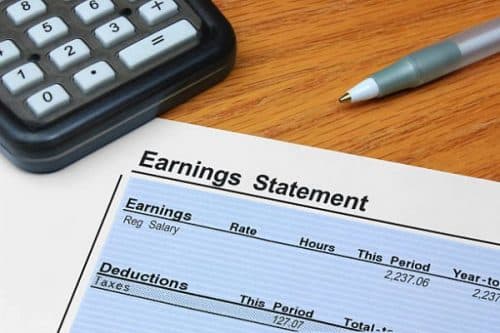An income statement, commonly known as a profit and loss statement (or P&L), is a crucial tool for determining, with appropriate formulas, how your company’s revenue and expenses compare.
Simply put, it notifies anyone whether your firm is profitable or not at a glance. An income statement is often a list of sales and expenses, with the company’s net profit at the bottom.
Have you ever heard a company’s “bottom line” referred to? They’re referring to the last line of an income statement, which shows a reader a company’s net profit, or how profitable it is over a set period of time (typically quarterly or annually) after all expenses have been taken into consideration.
Basically, when individuals say “profit and loss statement,” or what the “p” stands for in “P & L,” they’re referring to this “profit.” The term “loss,” on the other hand, refers to when expenses exceed revenue. In other words, when a business is not profitable, operating at a loss.
However, keep in mind that cash and earnings are totally different as you read on.
What is an Income Statement?
The income statement is one of three primary financial statements used to reflect a company’s financial performance over a certain accounting period, with the balance sheet and the statement of cash flows being the other two.
The Income Statement in your Business Plan
It is critical to include a forecasted income statement in your business strategy. Whether you’re making internal plans to keep your firm on track or developing a physical document to submit to investors, understanding whether your company expects to be profitable (or not) over time is pretty vital knowledge.
For starters, if you’re writing a business plan, you should begin with an executive summary and include all of the typical business plan components. But, a component of the financial plan that includes a projected balance sheet, projected cash flow statement, and projected income statement is a must-have. It’s also worth noting that the term “Pro-forma” is frequently used instead of “projected” in corporate planning. The meaning is, however, the same.
To get started, you can use our free samples and templates to build your balance sheet, cash flow statement, and income (P&L) statement.
Let’s look at an income statement in more detail now that you know what it is.
What are the important components of an income statement?
The following are some of the most important aspects of the income statement.
#1. Revenue
The money you have coming in, or your revenue from sales, will be the top line of your profit and loss statement. This aspect should reflect your total sales revenue before any deductions.
The top line of your income statement is equally as significant as the bottom line; this is where all of the direct expenditures and expenses will be deducted. So, if you want to stay in the black, your spending should be as modest as possible.
You might be asking how you’d come up with a sales number for financial projections when drafting a business plan document since revenues have not started flowing in. It’s common for a business plan’s financials to be an informed guess of what the following few years’ figures will be. But then these guesses or predictions would need to be entirely based on certain valid factors. These would lead to more feasible predictions when it comes to forecasts.
While no one can really forecast the future, you can design a strategy that works for you. This gets easier with a couple of sales forecasting and demand forecasting tools in your possession.
Alternatively, you could also employ the services of professionals to help you get real-time data for more feasible forecasts.
Read Also: What is Sales Forecasting? Methods and Real-World Examples
#1. Direct Costs
Direct costs, also known as cost of goods sold (COGS), are exactly what they sound like: how much does it cost you to create the product or provide the service associated with that sale? However, you wouldn’t include expenses like office rent in this category. It basically includes expenditures that directly contribute to the product you sell.
A bookstore’s direct cost of sales, for example, is the price it paid for the books it sold. However, a publisher’s direct costs include royalties, printing, paper, and ink. Materials and labor are also included in a manufacturer’s direct costs. The direct costs incurred by a reseller, on the other hand, are the costs incurred by the reseller in purchasing the products it sells.
Meanwhile, it’s conceivable to have no direct expenses or extremely low direct costs as a percentage of revenue if you just sell services. Nevertheless, even accountants and attorneys have subcontractors, research, and photocopying that might be included in direct costs.
To distinguish between direct costs and recurrent expenses, follow this easy rule of thumb: Whether you make one sale or a hundred, if you pay for something, it’s a monthly expense. Also, Also, salary, utilities, insurance, and rent are all things to consider.
#3. Gross Profit Margin
Gross profit is another term for gross margin. On your income statement, this amount represents the difference between revenue and direct costs.
Gross Margin = Revenue – Direct Costs
This number is crucial because it represents two critical pieces of information:
- How much of your revenue is diverted towards direct costs (the lower the amount, the better), and
- How much money is left over for the rest of the business’s expenses.
You’ll know you’re not profitable right away if the number after direct costs is less than the whole of your operating expenses.
#4. Operating Expenses
Operating expenses, excluding costs of products sold, are where you put all of your recurring expenses as line items.
So, take a look at everything else your company spends to stay afloat: rent, payroll, electricity, marketing—include all of those fixed costs here.
Keep in mind that each purchase does not require its own line item. It’s easier to read if you bundle things together into expense categories, such as office supplies or advertising costs.
#5. Operating Income
EBITDA, or earnings before interest, taxes, depreciation, and amortization, is another term for operating income. Subtract your entire operating expenses from your gross margin to get your operating income.
Operating Income = Gross Margin – Operating Expenses
Operating income is widely regarded as the most accurate indicator of a company’s profitability. As a result, keep an eye on this line item, especially if you’re presenting to investors.
#6. Interest
This is pretty self-explanatory—you’d add any interest payments the corporation makes on its loans or investments here.
#7. Amortization and Depreciation
These are non-cash expenses related to your tangible and intangible assets. Depreciation is an accounting concept based on the assumption that a tangible object loses value over time, such as a car or piece of machinery. After a few years, the asset will be valued less, and you’ll have to account for the loss on your P&L.
Amortization, on the other hand, is a concept that comes in handy when you want to write off the cost of intangible assets over time. A pretty good example is a copyright or patent that your company might buy from another corporation.
If your company paid $1 million for a patent that will last 20 years, you will be charged 1/20th of the amount every year for the rest of the patent’s life. This expense for an intangible asset would be included in the income statement’s amortization row.
#8. Taxes
Depending on whether you’re documenting prospective or actual values, this will indicate the income tax amount that has been paid or the amount that you intend to pay. Some businesses set aside a certain amount of money to cover this cost in anticipation.
#9. Total Expenses
Total expenses are the sum of all of your expenses, including interest, taxes, depreciation, and amortization.
To calculate your overall expenses, simply add your direct costs, operating expenses, and then interest, taxes, depreciation, and amortization:
Total Expenses = Direct Costs + Operating Expenses + Interest + Taxes + Depreciation + Amortization
#10. Net profit
The figurative bottom line is net profit, often known as net income or net earnings. This is the on-the-spot factor that will determine whether you’re in the red or not. Net profit is calculated by subtracting total expenses from revenue:
Revenue – Total Expenses = Net Profit
Remember that this amount began with your sales income on the top line. After that, everything else was deducted from the initial payment. If this number is negative, you’re operating at a loss. Either your expenses are too high, or your revenue is declining, or both, and it’s time to rethink your plan.
What is the Formula for the Income Statement?
For the most part, you can either calculate with the income statement formula using the single-step or multi-step method.
The income statement formula in the case of a single step is such that you calculate the net income by subtracting expenses from revenues. Mathematically;
Revenues – Expenses = Net Income
On the other hand, when there are several processes, the gross profit goes first by subtracting the cost of items sold from the proceeds. The operating income goes next by subtracting operating expenses from gross profit. Then the net income goes last by adding operating income and non-operating components.
The Income Statement Formula is as follows:
Revenues – Cost of Goods Sold = Gross Profit
Gross Profit – Operating Expenses = Operating Income
Operating Income + Non-operating Items = Net Income
The income statement formula for the multiple-step technique is as follows:
(Revenues + Non-operating items) – (Cost of goods sold + Operating expenses) = Net income
The Income Statement Formula Explained!!!
The following steps are used to calculate the income statement formula using the single-step method:
- To begin with, take note of the total of all revenue-generating sources from the profit and loss statement.
- Next, use the profit and loss account to calculate the cost of products sold. Raw material expenses are generally included in the cost of goods sold. The gross profit can then be computed by subtracting the cost of products sold from the revenues in this phase. It looks like this:
Revenues – Cost of Goods Sold = Gross Profit
- Following that, the income statement’s operating expenses are gathered. Selling expenses make up the majority of operating expenses, administrative costs, and so on. The operational income can now be computed in this stage by subtracting operating expenses from the gross profit, as illustrated below.
Operating income = Gross profit – Operating expenses
- After that, figure out the non-operating elements like interest income, one-time payments, and so on. Finally, net income is calculated by subtracting non-operating items from operating income as illustrated below;
Net income = Operating income + Non-operating items
How Do You Explain Income Statement?
An income statement, commonly known as a profit and loss statement (or P&L), is a crucial tool for determining how your company’s revenue and expenses compare. It is one of three primary financial statements used to reflect a company’s financial performance over a certain accounting period, with the balance sheet and the statement of cash flows being the other two.
What Are the 3 Main Parts of an Income Statement?
The 3 main parts of an income statement include; revenues, expenses, and net income.
Why Do We Need an Income Statement?
Businesses need income statements because it notifies prospective investors or business owners whether their firms are profitable or not at a glance. An income statement is often a list of sales and expenses, with the company’s net profit at the bottom
What Is the Income Statement Formula?
An income statement’s basic formula is Revenues – Expenses = Net Income. This simple equation determines whether or not the company is profitable. A business is profitable if its sales exceed its expenses.
What Is Another Name for Income Statement?
An income statement summarizes a company’s sales, expenses, and profitability over time. It is also referred to as a profit-and-loss (P&L) or earnings statement.






